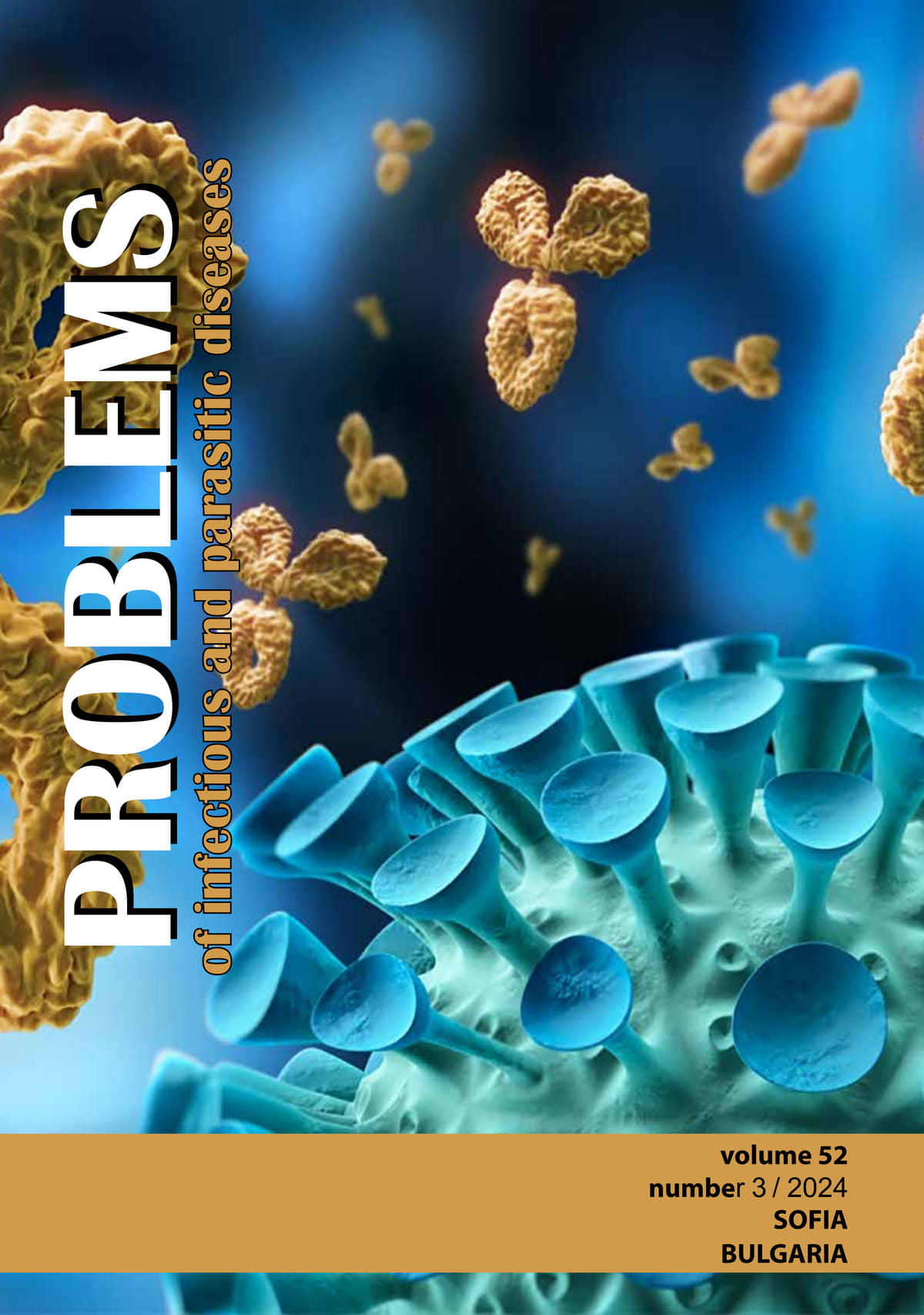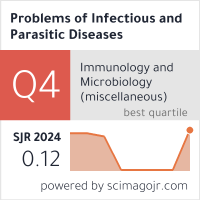BABESIOSIS IN HUMANS
A BRIEF LITERATURE REVIEW
DOI:
https://doi.org/10.58395/bck6nm60Keywords:
babesiosis, etiology, distribution, treatmentAbstract
Babesiosis is a tick-borne parasitic disease caused by the intraerythrocytic protozoan Babesia spp. and transmitted primarily by Ixodes ticks. The geographical distribution of the parasites coincides with the regions where their tick vectors are prevalent. More than 50 cases of human babesiosis have been reported in Europe, mainly associated with Babesia divergens, which causes acute disease in cattle and is transmitted by Ixodes ricinus. In contrast, the incidence of the disease in the USA is approximately 2000 cases per year, with the main causative agent being Babesia microti and the tick vector being Ixodes scapularis. Although babesiosis is primarily an animal disease, humans can also become acutely ill, particularly splenectomized and immunocompromised individuals. Clinical manifestations range from asymptomatic to severe disease with symptoms including fever, chills, hemoglobinuria and anemia. There is a risk of potentially fatal complications such as acute respiratory, renal or multi-organ failure, particularly in vulnerable populations. Diagnosis is primarily based on light microscopy and PCR testing, while serological methods are more appropriate for epidemiological studies. Treatment regimens typically include a 7-10 day course of either atovaquone plus azithromycin or clindamycin plus quinine. Human cases are associated with outdoor activities or living in rural areas during the warm months when tick activity is at its peak. Because of the increasing incidence in endemic regions and the potentially serious clinical consequences, babesiosis should be considered in the differential diagnosis of febrile illnesses of unknown origin.
Downloads
References
1. Zimmer AJ, Simonsen KA. Babesiosis. 2023 Jul 31. In: StatPearls [Internet]. Treasure Island (FL): StatPearls Publishing; 2024 Jan–. PMID: 28613466.
2. Schnittger, L., Rodriguez, A. E., Florin-Christensen, M., & Morrison, D. A. (2012). Babesia: a world emerging. Infection, genetics and evolution : journal of molecular epidemiology and evolutionary genetics in infectious diseases, 12(8), 1788–1809. https://doi.org/10.1016/j.meegid.2012.07.004
3. Kumar, A., O'Bryan, J., & Krause, P. J. (2021). The Global Emergence of Human Babesiosis. Pathogens (Basel, Switzerland), 10(11), 1447. https://doi.org/10.3390/pathogens10111447
4. Levine, N. D., Corliss, J. O., Cox, F. E., Deroux, G., Grain, J., Honigberg, B. M., Leedale, G. F., Loeblich, A. R., 3rd, Lom, J., Lynn, D., Merinfeld, E. G., Page, F. C., Poljansky, G., Sprague, V., Vavra, J., & Wallace, F. G. (1980). A newly revised classification of the protozoa. The Journal of protozoology, 27(1), 37–58. https://doi.org/10.1111/j.1550-7408.1980.tb04228.x
5. Homer, M. J., Aguilar-Delfin, I., Telford, S. R., 3rd, Krause, P. J., & Persing, D. H. (2000). Babesiosis. Clinical microbiology reviews, 13(3), 451–469. https://doi.org/10.1128/CMR.13.3.451
6. Jalovecka, M., Sojka, D., Ascencio, M., & Schnittger, L. (2019). Babesia Life Cycle - When Phylogeny Meets Biology. Trends in parasitology, 35(5), 356–368. https://doi.org/10.1016/j.pt.2019.01.007
7. Blackman, M. J., & Bannister, L. H. (2001). Apical organelles of Apicomplexa: biology and isolation by subcellular fractionation. Molecular and biochemical parasitology, 117(1), 11–25. https://doi.org/10.1016/s0166-6851(01)00328-0
8. Jalovecka, M., Hajdusek, O., Sojka, D., Kopacek, P., & Malandrin, L. (2018). The Complexity of Piroplasms Life Cycles. Frontiers in cellular and infection microbiology, 8, 248. https://doi.org/10.3389/fcimb.2018.00248
9. Zintl, A., Mulcahy, G., Skerrett, H. E., Taylor, S. M., & Gray, J. S. (2003). Babesia divergens, a bovine blood parasite of veterinary and zoonotic importance. Clinical microbiology reviews, 16(4), 622–636. https://doi.org/10.1128/CMR.16.4.622-636.2003
10. Laurence Malandrin, Maggy Jouglin, Yi Sun, Nadine Brisseau, Alain Chauvin. Redescription of Babesia capreoli (Enigk and Friedhoff, 1962) from roe deer (Capreolus capreolus): Isolation, cultivation, host specificity, molecular characterisation and differentiation from Babesia divergens, International Journal for Parasitology, Volume 40, Issue 3, 2010, Pages 277-284, ISSN 0020-7519, https://doi.org/10.1016/j.ijpara.2009.08.008
11. Onyiche, T. E., Răileanu, C., Fischer, S., & Silaghi, C. (2021). Global Distribution of Babesia Species in Questing Ticks: A Systematic Review and Meta-Analysis Based on Published Literature. Pathogens (Basel, Switzerland), 10(2), 230. https://doi.org/10.3390/pathogens10020230
12. Kjemtrup, A. M., & Conrad, P. A. (2000). Human babesiosis: an emerging tick-borne disease. International journal for parasitology, 30(12-13), 1323–1337. https://doi.org/10.1016/s0020-7519(00)00137-5
13. Michael J. Yabsley, Barbara C. Shock, Natural history of Zoonotic Babesia: Role of wildlife reservoirs, International Journal for Parasitology: Parasites and Wildlife, Volume 2, 2013, Pages 18-31, ISSN 2213-2244, https://doi.org/10.1016/j.ijppaw.2012.11.003.
14. SKRABALO, ZDENKO; DEANOVIC, Zivan. Piroplasmosis in Man. Report on a Case. 1957.
15. Hildebrandt, A., Zintl, A., Montero, E., Hunfeld, K. P., & Gray, J. (2021). Human Babesiosis in Europe. Pathogens (Basel, Switzerland), 10(9), 1165. https://doi.org/10.3390/pathogens10091165
16. Sipos D, Kappéter Á, Réger B, Kiss G, Takács N, Farkas R, et al. (2024). Confirmed Case of Autochthonous Human Babesiosis, Hungary. Emerg Infect Dis. 30(9),1972-1974. https://doi.org/10.3201/eid3009.240525
17. Scholtens, R. G., Braff, E. H., Healey, G. A., & Gleason, N. (1968). A case of babesiosis in man in the United States. The American journal of tropical medicine and hygiene, 17(6), 810–813. https://doi.org/10.4269/ajtmh.1968.17.810
18. Peter J Krause, Paul G Auwaerter, Raveendhara R Bannuru, John A Branda, Yngve T Falck-Ytter, Paul M Lantos, Valéry Lavergne, H Cody Meissner, Mikala C Osani, Jane Glazer Rips, Sunil K Sood, Edouard Vannier, Elizaveta E Vaysbrot, Gary P Wormser, Clinical Practice Guidelines by the Infectious Diseases Society of America (IDSA): 2020 Guideline on Diagnosis and Management of Babesiosis, Clinical Infectious Diseases, Volume 72, Issue 2, 15 January 2021, Pages e49–e64, https://doi.org/10.1093/cid/ciaa1216
19. Kurdova. R. Babesioses In: Clinical Parasitology and Tropical Medicine, Petrov P., Kurdova R. (eds.), East-West, 2016, 248-253.
20. Gorenflot, A., Moubri, K., Precigout, E., Carcy, B., & Schetters, T. P. (1998). Human babesiosis. Annals of tropical medicine and parasitology, 92(4), 489–501. https://doi.org/10.1080/00034989859465
21. Hildebrandt, A., Gray, J. S., & Hunfeld, K. P. (2013). Human babesiosis in Europe: what clinicians need to know. Infection, 41(6), 1057–1072. https://doi.org/10.1007/s15010-013-0526-8
22. Haapasalo, K., Suomalainen, P., Sukura, A., Siikamaki, H., & Jokiranta, T. S. (2010). Fatal babesiosis in man, Finland, 2004. Emerging infectious diseases, 16(7), 1116–1118. https://doi.org/10.3201/eid1607.091905
23. O'Connell, S., Lyons, C., Abdou, M., Patowary, R., Aslam, S., Kinsella, N., Zintl, A., Hunfeld, K. P., Wormser, G. P., Gray, J., Merry, C., & Alizadeh, H. (2017). Splenic dysfunction from celiac disease resulting in severe babesiosis. Ticks and tick-borne diseases, 8(4), 537–539. https://doi.org/10.1016/j.ttbdis.2017.02.016
24. Paleau, A., Candolfi, E., Souply, L., De Briel, D., Delarbre, J. M., Lipsker, D., Jouglin, M., Malandrin, L., Hansmann, Y., & Martinot, M. (2020). Human babesiosis in Alsace. Medecine et maladies infectieuses, 50(6), 486–491. https://doi.org/10.1016/j.medmal.2019.08.007
25. Centeno-Lima, S., Do Rosário, V., Parreira, R., Maia, A.J., Freudenthal, A.M., Nijhof, A.M. and Jongejan, F. (2003), A fatal case of human babesiosis in Portugal: molecular and phylogenetic analysis. Tropical Medicine & International Health, 8:760-764. https://doi.org/10.1046/j.1365-3156.2003.01074.x
26. Corpelet, C., Vacher, P., Coudore, F., Laurichesse, H., Conort, N., & Souweine, B. (2005). Role of quinine in life-threatening Babesia divergens infection successfully treated with clindamycin. European journal of clinical microbiology & infectious diseases : official publication of the European Society of Clinical Microbiology, 24(1), 74–75. https://doi.org/10.1007/s10096-004-1270-x
27. Mørch, K., Holmaas, G., Frolander, P. S., & Kristoffersen, E. K. (2015). Severe human Babesia divergens infection in Norway. International journal of infectious diseases : IJID : official publication of the International Society for Infectious Diseases, 33, 37–38. https://doi.org/10.1016/j.ijid.2014.12.034
28. Denes, E., Rogez, J. P., Dardé, M. L., & Weinbreck, P. (1999). Management of Babesia divergens babesiosis without a complete course of quinine treatment. European journal of clinical microbiology & infectious diseases : official publication of the European Society of Clinical Microbiology, 18(9), 672–673. https://doi.org/10.1007/s100960050373
29. Lobo, C. A., Singh, M., & Rodriguez, M. (2020). Human babesiosis: recent advances and future challenges. Current opinion in hematology, 27(6), 399–405. https://doi.org/10.1097/MOH.0000000000000606
30. Uhnoo, I., Cars, O., Christensson, D., & Nyström-Rosander, C. (1992). First documented case of human babesiosis in Sweden. Scandinavian journal of infectious diseases, 24(4), 541–547. https://doi.org/10.3109/00365549209052642
31. González, L. M., Castro, E., Lobo, C. A., Richart, A., Ramiro, R., González-Camacho, F., Luque, D., Velasco, A. C., & Montero, E. (2015). First report of Babesia divergens infection in an HIV patient. International journal of infectious diseases : IJID : official publication of the International Society for Infectious Diseases, 33, 202–204. https://doi.org/10.1016/j.ijid.2015.02.005
32. Martinot, M., Zadeh, M. M., Hansmann, Y., Grawey, I., Christmann, D., Aguillon, S., Jouglin, M., Chauvin, A., & De Briel, D. (2011). Babesiosis in immunocompetent patients, Europe. Emerging infectious diseases, 17(1), 114–116. https://doi.org/10.3201/eid1701.100737
33. Chan WY, MacDonald C, Keenan A, Xu K, Bain BJ, Chiodini PL. Severe babesiosis due to Babesia divergens acquired in the United Kingdom. Am J Hematol. 2021; 96: 889–890. https://doi.org/10.1002/ajh.26097
34. Gonzalez, L. M., Rojo, S., Gonzalez-Camacho, F., Luque, D., Lobo, C. A., & Montero, E. (2014). Severe babesiosis in immunocompetent man, Spain, 2011. Emerging infectious diseases, 20(4), 724–726. https://doi.org/10.3201/eid2004.131409
35. Kukina IV, Zelya OP, Guzeeva TM, Karan LS, Perkovskaya IA, Tymoshenko NI, Guzeeva MV. Severe babesiosis caused by Babesia divergens in a host with intact spleen, Russia, 2018. Ticks Tick Borne Dis. 2019 Oct;10(6):101262. Epub 2019 Jul 16. PMID: 31327745. https://doi.org/10.1016/j.ttbdis.2019.07.006
36. Asensi, V., González, L. M., Fernández-Suárez, J., Sevilla, E., Navascués, R. Á., Suárez, M. L., Lauret, M. E., Bernardo, A., Carton, J. A., & Montero, E. (2018). A fatal case of Babesia divergens infection in Northwestern Spain. Ticks and tick-borne diseases, 9(3), 730–734. https://doi.org/10.1016/j.ttbdis.2018.02.018
37. Lempereur, L., Shiels, B., Heyman, P., Moreau, E., Saegerman, C., Losson, B., & Malandrin, L. (2015). A retrospective serological survey on human babesiosis in Belgium. Clinical microbiology and infection : the official publication of the European Society of Clinical Microbiology and Infectious Diseases, 21(1), 96.e1–96.e967. https://doi.org/10.1016/j.cmi.2014.07.004
38. Gabrielli, S., Calderini, P., Cassini, R., Galuppi, R., Tampieri, M. P., Pietrobelli, M., & Cancrini, G. (2014). Human exposure to piroplasms in Central and Northern Italy. Veterinaria italiana, 50(1), 41–47. https://doi.org/10.12834/VetIt.1302.13
39. Hunfeld, K. P., Lambert, A., Kampen, H., Albert, S., Epe, C., Brade, V., & Tenter, A. M. (2002). Seroprevalence of Babesia infections in humans exposed to ticks in midwestern Germany. Journal of clinical microbiology, 40(7), 2431–2436. https://doi.org/10.1128/JCM.40.7.2431-2436.2002
40. Svensson J, Hunfeld KP, Persson KEM. High seroprevalence of Babesia antibodies among Borrelia burgdorferi-infected humans in Sweden. Ticks Tick Borne Dis. 2019 Jan;10(1):186-190. Epub 2018 Oct 28. PMID: 30389326. https://doi.org/10.1016/j.ttbdis.2018.10.007
41. Madison-Antenucci, S., Kramer, L. D., Gebhardt, L. L., & Kauffman, E. (2020). Emerging Tick-Borne Diseases. Clinical microbiology reviews, 33(2), e00083-18. https://doi.org/10.1128/CMR.00083-18
42. Vannier, E., Gewurz, B. E., & Krause, P. J. (2008). Human babesiosis. Infectious disease clinics of North America, 22(3), 469–ix. https://doi.org/10.1016/j.idc.2008.03.010
43. Żukiewicz-Sobczak, W., Zwoliński, J., Chmielewska-Badora, J., Galińska, E. M., Cholewa, G., Krasowska, E., Zagórski, J., Wojtyła, A., Tomasiewicz, K., & Kłapeć, T. (2014). Prevalence of antibodies against selected zoonotic agents in forestry workers from eastern and southern Poland. Annals of agricultural and environmental medicine : AAEM, 21(4), 767–770. https://doi.org/10.5604/12321966.1129930
44. Hunfeld, K. P., Hildebrandt, A., & Gray, J. S. (2008). Babesiosis: recent insights into an ancient disease. International journal for parasitology, 38(11), 1219–1237. https://doi.org/10.1016/j.ijpara.2008.03.001
45. Healy, G. R., & Ruebush, T. K., 2nd (1980). Morphology of Babesia microti in human blood smears. American journal of clinical pathology, 73(1), 107–109. https://doi.org/10.1093/ajcp/73.1.107
46. Renard, I., & Ben Mamoun, C. (2021). Treatment of Human Babesiosis: Then and Now. Pathogens (Basel, Switzerland), 10(9), 1120. https://doi.org/10.3390/pathogens10091120
47. Clinical Care of Babesiosis. Centers for Disease Control and Prevention. Available at https://www.cdc.gov/babesiosis/hcp/clinical-care/index.html
Downloads
Published
Issue
Section
License
Copyright (c) 2025 Zornitsa Traykova (Author)

This work is licensed under a Creative Commons Attribution 4.0 International License.






